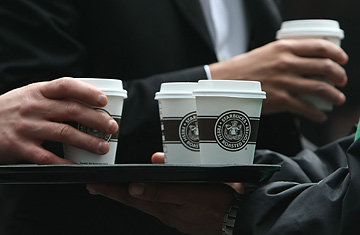
Free samples of Starbucks' new Pike Place Roast are handed out in Bryant Park April 8, 2008 in New York City.
I drink coffee all day. Mmmmmcoffeecoffeecoffee. A typical coffee day for me is: pot of caffeinated before breakfast; pot of decaf after dropping the kids off; iced coffee from the leftovers while I write in the morning; cup of coffee from the office machine before a meeting in the afternoon; furtive swig of the dregs of a cup I discover on my desk at the end of the day. Don't you judge me.
So when TIME.com asked me at five in the afternoon if I'd go down to Starbucks, get a cup of their new Pike Place Roast and review it, I naturally said yes. Especially because I was on deadline to finish writing the table of contents for Friday's TIME magazine. If your issue arrives late this week, my bad.
Pike Place is Starbucks' attempt to address complaints that its regular cup of joe is bitter, overroasted and "burnt." The criticisms are partly valid (the result of roasting beans black and leaving pots to sit around until they reduce to a 10W40-like sauce), partly not (the result of customers being wusses who don't like dark-roasted coffee). Pike Place aims to fix this through technique (Pike Place is not supposed to sit for more than 30 minutes) and blending (it aims for a lighter, brighter mix of beans). The aim is a cup that's more broadly friendly, less overwhelming, more (though they would probably never say this) like Dunkin Donuts'.
The result, though, is a cup of coffee that tastes less like a cup of coffee. My first sip of Pikes Place was simultaneously harsh and weak. (OK, actually, my first sip was dominated by notes of overwhelming pain, because of the universal takeout practice of boiling coffee like the cauldrons of Hell so it arrives at its destination warm.) The lighter roast results in some brighter notes, but it also gives you a less full-bodied coffee — yet one that still tasted a little overboiled. (Maybe I'd caught the pot toward the end of its 30-minute shelf life.)
Nothing risky or distinctive — no wine-y, Kenya-like acidity, none of the super-richness of my favorite Sumatra (which I looked longingly at on the menu while ordering the Pikes Place) — just a blend that tasted like the American statistical coffee median. Starbucks says it took input from about 1,000 customers in designing Pike Place, and I could taste every one of them in there. This was a cup of coffee brewed by committee.
All in all, not a bad cup — nothing too objectionable, a perfectly fine if not completely fresh-tasting cup of coffee that I might expect to get at Dunkin, or, on a good day, Mickey D's. Which is the problem: Starbucks is staking its future on making a cup of coffee for people who don't like Starbucks — a McDLT in a cup. And maybe it has to. Maybe, because of its own success, Starbucks has changed America into two consumeriats, one dedicated to their artisanal, fussy, shade-grown, Fair Trade microvarietals of Cafe Froufrou, and one that just wants a more competently made cup of not-too-dark, coffee-flavored coffee with their bagels and bear claws.
If that's the case, I guess I can't blame Starbucks, big as it's grown, for wanting to land on the bigger side of that divide. Nor can I come up with a better suggestion for them if they want to improve their standing in the market. But ask me in a hour, after I've had my third pot of coffee.
